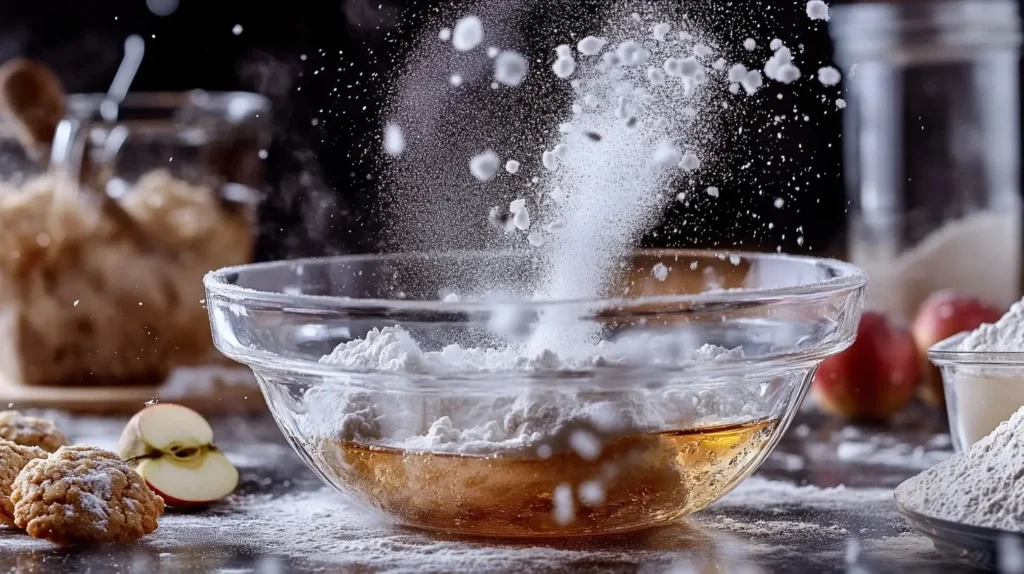Why do you put apple cider vinegar in cookies? This common baking ingredient enhances texture, acts as a natural leavening agent, and adds subtle tangy notes. While it may seem unusual, apple cider vinegar plays a vital role in achieving soft, chewy cookies. In this article, we’ll explore the science behind its benefits, how it improves cookie structure, and tips for using it effectively in baking.
What Is Apple Cider Vinegar?
Apple cider vinegar (ACV) is a vinegar derived from fermented apple juice. The process involves crushing apples, extracting their juice, and fermenting it with yeast and bacteria to convert sugars into alcohol and then acetic acid. This acetic acid gives ACV its tangy taste and pungent smell, which make it stand out among other vinegars.
Historically, apple cider vinegar has been used for both culinary and medicinal purposes. Ancient civilizations, including the Babylonians and Romans, valued it as a preservative and flavoring agent. Today, it’s a household staple used in everything from cleaning to cooking, prized for its versatility and natural properties.
How Apple Cider Vinegar Improves Cookies
Apple cider vinegar shines as a versatile ingredient in kitchens worldwide. Its acidic profile makes it perfect for salad dressings, where it blends beautifully with oils and spices to create a balanced tang. Similarly, it works wonders in marinades, tenderizing meats and enhancing flavors without adding calories or unwanted fat.
In pickling, ACV plays a key role in preserving foods while imparting a distinct tartness. Many people also use it to create flavorful reductions or add a zesty twist to soups and sauces. Its unique ability to balance sweet, sour, and savory flavors makes it an indispensable part of culinary art. But, as we’ll discover, apple cider vinegar isn’t limited to savory dishes—it’s also a surprising hero in baked goods like cookies!
For detailed recipes and expert tips on making apple cookies, check out our guide: Apple Cookies: Irresistible Recipes, Tips, and Ideas for Perfect Treats.
Tips for Using Apple Cider Vinegar in Cookies
Baking with apple cider vinegar may sound unusual, but it’s a secret weapon for bakers aiming to achieve soft, chewy, and well-risen cookies. The key lies in its acidity, which reacts with alkaline ingredients like baking soda. This reaction produces carbon dioxide, creating tiny bubbles in the dough that contribute to a light, airy texture.
Moreover, ACV acts as a mild flavor enhancer, subtly amplifying the sweetness of cookies while toning down overpowering flavors. And don’t worry—its tangy taste fades during baking, leaving no trace of vinegar in your final product.
For vegan bakers, apple cider vinegar is indispensable. When paired with plant-based ingredients, it mimics the properties of eggs, binding dough together and helping it rise. This makes it a go-to substitute in vegan cookie recipes. With so many benefits packed into a simple ingredient, it’s no wonder apple cider vinegar has earned a place in the baker’s pantry!

Role of Acids in Baking
Acids play a pivotal role in baking, often working behind the scenes to create the perfect texture and structure. When acidic ingredients, like apple cider vinegar, come into contact with baking soda (a base), a chemical reaction occurs. This reaction produces carbon dioxide gas, which forms tiny bubbles in the dough or batter. These bubbles are what give baked goods their light, airy quality.
In cookies, the interaction of acids and bases is essential for leavening. While cookies don’t rise as much as cakes or bread, a little lift is crucial for achieving a tender, slightly puffy texture. Beyond leavening, acids can also influence flavor by balancing sweetness and enhancing the complexity of other ingredients. Apple cider vinegar, with its mild acidity, is a perfect candidate for this task.
How Does Apple Cider Vinegar React with Baking Soda in Cookies?
When apple cider vinegar is mixed with baking soda, a fascinating reaction takes place. Baking soda, or sodium bicarbonate, is an alkaline substance. Apple cider vinegar, rich in acetic acid, acts as the acidic counterpart. When combined, the acid neutralizes the base, releasing carbon dioxide gas in the process.
This reaction occurs almost instantly, creating a fizzing effect as gas bubbles form. In baking, these bubbles are trapped within the dough, causing it to expand. This is why recipes often call for mixing wet and dry ingredients quickly—to maximize the leavening power before the reaction subsides.
For cookies, this process leads to a slight rise and a softer crumb. The reaction also helps distribute the leavening action evenly, ensuring your cookies bake uniformly. Importantly, because apple cider vinegar is milder than other acids like lemon juice, it imparts a subtle tang without overpowering the recipe.

How Apple Cider Vinegar Affects Cookie Dough and Texture
The reaction between apple cider vinegar and baking soda doesn’t just create bubbles—it also alters the dough’s texture. As the gas bubbles form, they push apart the dough’s structure, making it lighter and less dense. This is especially noticeable in cookies, where achieving the right balance between firmness and softness is key.
In addition to creating a more tender texture, the reaction helps the dough hold moisture. This is why cookies made with apple cider vinegar often have a chewy interior and a slightly crisp edge. The acid also interacts with gluten proteins, breaking them down slightly to prevent toughness. This is particularly beneficial in cookie recipes where overmixing can lead to a dense, hard final product.
Overall, incorporating apple cider vinegar into your cookie dough not only helps with leavening but also enhances the overall mouthfeel and consistency. It’s a small addition with big results!
Recommended Quantity of Apple Cider Vinegar
The amount of apple cider vinegar you should use in your cookie recipe largely depends on the recipe itself. Generally, 1 to 2 teaspoons of apple cider vinegar is sufficient for most standard-sized batches, which typically yield about two dozen cookies. This small quantity provides the necessary acidity to react with baking soda and improve the texture without overwhelming the flavor.
For recipes with stronger flavors, like chocolate chip or gingerbread cookies, you might lean closer to 2 teaspoons to ensure proper leavening. On the other hand, delicate recipes, such as sugar cookies, may only require 1 teaspoon to maintain their subtle sweetness.
It’s always a good idea to follow your recipe closely, but feel free to experiment slightly. Start with a conservative amount, as a little apple cider vinegar goes a long way in achieving the desired effect.
Step-by-Step Guide to Incorporating Apple Cider Vinegar
Adding apple cider vinegar to your cookie recipe is simple, but timing and technique matter to ensure it works effectively. Here’s a straightforward guide to get it right:
- Prepare Ingredients
Measure out the apple cider vinegar according to your recipe’s instructions. Ensure that it’s fresh and at room temperature to avoid altering the dough’s temperature. - Mix Wet Ingredients
Combine the vinegar with other liquid ingredients, such as eggs, milk, or vanilla extract. This ensures even distribution throughout the dough. - Combine Dry Ingredients
In a separate bowl, mix the baking soda, flour, sugar, and other dry ingredients. Keep the baking soda separate from the vinegar until you’re ready to mix everything together. - Combine Wet and Dry Mixtures
Slowly add the wet ingredients (containing the vinegar) to the dry mixture. Stir gently but thoroughly to allow the vinegar and baking soda to react. This step is crucial for creating carbon dioxide bubbles, which contribute to a tender texture. - Avoid Overmixing
Once combined, avoid overmixing the dough. Overworking the dough can break the delicate structure of the bubbles, resulting in a denser cookie. - Bake Immediately
After mixing, bake the cookies promptly. The reaction between the vinegar and baking soda is most effective right after mixing, so don’t let the dough sit too long before baking.
This step-by-step process ensures you get the full benefit of apple cider vinegar in your cookies, from leavening to flavor enhancement.
Popular Cookie Recipes Featuring Apple Cider Vinegar
Adding apple cider vinegar to your cookie repertoire can elevate classic recipes to new heights. Here are some popular cookie types where apple cider vinegar shines:
1. Chocolate Chip Cookies
A small amount of apple cider vinegar enhances the rise of the dough, giving these cookies a chewy center with a slight crisp on the edges. The vinegar also balances the sweetness of the chocolate, creating a perfectly balanced bite.
2. Gingerbread Cookies
In spiced cookies like gingerbread, apple cider vinegar brightens the flavor profile and complements the warming spices. Its acidity helps maintain a soft texture, making these cookies ideal for decorating or enjoying plain.
3. Vegan Peanut Butter Cookies
For egg-free recipes, apple cider vinegar serves as an excellent binder. In vegan peanut butter cookies, it contributes to a moist, cohesive dough that holds its shape during baking.
4. Oatmeal Raisin Cookies
In these hearty cookies, apple cider vinegar keeps the oats from becoming too dense while enhancing the natural sweetness of raisins.
5. Sugar Cookies
In sugar cookies, apple cider vinegar ensures a soft, delicate texture while helping the dough hold its shape for cookie cutters.
With its versatility and subtle impact, apple cider vinegar is a fantastic addition to a wide range of cookie recipes. Why not give one of these a try?

Will My Cookies Taste Like Vinegar?
One common concern among bakers is whether adding apple cider vinegar to cookies will leave behind a strong, tangy flavor. Fortunately, the answer is no! When properly measured and incorporated, the vinegar taste completely disappears during baking.
The heat of the oven neutralizes the sharpness of apple cider vinegar while allowing its acidic properties to do their job. As it reacts with baking soda, the vinegar’s distinct flavor transforms into a subtle undertone that enhances other ingredients without being noticeable.
For those who are especially sensitive to vinegar flavors, sticking to the recommended quantity—1 to 2 teaspoons per recipe—ensures that it remains undetectable. So, rest assured, your cookies won’t have even a hint of sourness. Instead, they’ll taste balanced, with just the right texture and sweetness.
Potential Allergies and Sensitivities
While apple cider vinegar is generally safe for most people, it’s important to consider potential allergies or sensitivities. Although rare, some individuals may have reactions to the acetic acid or trace elements found in vinegar.
For those with known allergies to apples or fermented products, it’s wise to consult a healthcare provider before using apple cider vinegar in recipes. Additionally, individuals with sensitive digestive systems may find it helpful to read more about potential effects of apple cider vinegar on health to better understand its impact.
Always label baked goods when sharing them, especially if you’re preparing treats for others with unknown dietary restrictions. Transparency ensures everyone can enjoy your cookies safely and without concern.
Adjusting Recipes for Dietary Restrictions
Baking with apple cider vinegar offers flexibility for adapting recipes to meet dietary needs, such as vegan or gluten-free preferences. Here’s how to modify your cookie recipes without sacrificing taste or texture:
| Dietary Restriction | Adjustment | How Apple Cider Vinegar Helps |
|---|---|---|
| Vegan | Replace eggs with a mixture of 1 tablespoon apple cider vinegar and 2 tablespoons water per egg. | Acts as a binder and helps leaven the dough. |
| Gluten-Free | Substitute all-purpose flour with a gluten-free blend. | Breaks down proteins in flour alternatives for better texture. |
| Low Sugar | Use natural sweeteners like stevia or coconut sugar. | Balances sweetness and prevents overpowering flavors. |
| Dairy-Free | Replace milk or butter with plant-based alternatives. | Maintains the dough’s consistency and moisture. |
For vegan cookies, apple cider vinegar is particularly effective when combined with baking soda, creating a reaction similar to the leavening action of eggs. Gluten-free cookies also benefit from the acidity, which improves the dough’s elasticity and prevents crumbling.
By using apple cider vinegar creatively, you can cater to various dietary needs while ensuring your cookies remain delicious and appealing to everyone.
Frequently Asked Questions
What Does Apple Cider Vinegar Do in Baking?
Apple cider vinegar plays a vital role in baking, particularly in recipes that rely on a chemical reaction for leavening. When combined with baking soda, the acidic vinegar triggers a reaction that produces carbon dioxide gas. This gas forms bubbles in the dough, helping cookies rise slightly and giving them a light, tender texture.
Beyond leavening, apple cider vinegar subtly enhances the flavor of cookies. It balances the sweetness, enriches the taste of other ingredients, and ensures the final product is neither too sweet nor bland. This dual purpose makes it a hidden gem in many cookie recipes!
Can I Substitute Other Vinegars for Apple Cider Vinegar in Cookie Recipes?
Yes, you can substitute other vinegars for apple cider vinegar in cookie recipes, but the results may vary. White vinegar is a common replacement, as it has a similar acidity level, but it lacks the subtle fruity undertones of apple cider vinegar.
Other options, like rice vinegar or malt vinegar, may work, but their milder acidity or unique flavors might not achieve the same leavening and flavor-balancing effects. If you’re in a pinch, lemon juice can also be used as a substitute. However, it’s best to stick with apple cider vinegar whenever possible for the most consistent results in texture and taste.
How to Make Apple Cookies
Apple cookies are a delicious way to enjoy the warm, comforting flavors of apple and cinnamon. Here’s a simple method:
- Ingredients: Gather diced apples, flour, sugar, butter (or vegan substitute), apple cider vinegar, cinnamon, and baking soda.
- Mix Dry Ingredients: In a bowl, combine flour, baking soda, cinnamon, and a pinch of salt.
- Prepare Wet Ingredients: Cream butter and sugar, then add apple cider vinegar and mix until smooth.
- Combine: Gradually fold the dry ingredients into the wet mixture. Add diced apples.
- Bake: Spoon the dough onto a baking sheet and bake at 350°F (175°C) for 10-12 minutes.
Looking for a step-by-step guide to ensure your apple cookies turn out perfectly? Don’t miss this detailed guide: How to Make Apple Cookies: A Step-by-Step Guide for Perfect Treats
What Is the Golden Rule in Baking Cookies?
The golden rule in baking cookies is to measure your ingredients accurately. Baking is a science, and even small variations can affect the outcome. Use measuring cups for dry ingredients and liquid measuring cups for wet ones. Level off dry ingredients with a knife and avoid packing flour too tightly.
Also, don’t skip preheating the oven—it ensures even baking. Finally, follow the recipe steps carefully, especially when combining wet and dry ingredients, as timing can impact the texture and rise of your cookies.
To learn more about the key principles and techniques behind the golden rule, visit our detailed guide: The Golden Rule in Baking Cookies: Achieve Perfect Results Every Time.
How to Make Chewy vs. Crunchy Cookies?
The secret to chewy or crunchy cookies lies in ingredient ratios and baking techniques:
- Chewy Cookies: Use more brown sugar than white sugar, as brown sugar retains moisture. Add an extra egg yolk and bake at a slightly lower temperature to keep the center soft.
- Crunchy Cookies: Opt for more white sugar, which creates a crisper texture. Reduce moisture by using less butter and bake at a slightly higher temperature to achieve golden, crunchy edges.
For a detailed comparison and expert tips, read our guide: How to Make Chewy vs Crunchy Cookies: The Ultimate Guide.
What Is the Secret to Making the Best Cookies?
The secret to amazing cookies is balancing ingredients, using quality components, and paying attention to technique. Here are some tips:
- Room Temperature Ingredients: Ensure butter, eggs, and liquids are at room temperature for even mixing.
- Chill the Dough: Refrigerating cookie dough before baking improves texture and prevents spreading.
- Don’t Overmix: Stir only until the ingredients are combined to avoid tough cookies.
- Perfect Timing: Remove cookies from the oven just as the edges turn golden; they’ll continue cooking on the hot tray.
- Apple Cider Vinegar: Add a teaspoon to achieve that soft, tender texture while enhancing flavor balance.
Follow these tips, and you’ll create cookies that are not just good but unforgettable!
Recap of the Benefits of Using Apple Cider Vinegar in Cookies
Apple cider vinegar may seem like an unusual addition to cookie recipes, but its benefits are undeniable. First and foremost, it acts as a natural leavening agent, reacting with baking soda to create a light and tender texture. This reaction ensures cookies rise beautifully while maintaining their chewiness.
In addition to improving texture, apple cider vinegar subtly balances flavors, enhancing the sweetness and richness of other ingredients. Its versatility shines in a variety of recipes, from classic chocolate chip to spiced gingerbread cookies. Moreover, its natural preservative properties help cookies stay fresh longer, making it an excellent choice for bakers planning ahead.
For those with dietary restrictions, apple cider vinegar offers unique solutions. It works as an egg substitute in vegan recipes and improves the texture of gluten-free baked goods. These benefits make it a powerhouse ingredient for both traditional and alternative baking methods.
Encouragement to Experiment with Apple Cider Vinegar in Baking
If you’ve never tried adding apple cider vinegar to your cookies, now’s the time! This small, simple ingredient can make a big difference in your baking. It’s not just about chemistry—it’s about achieving the perfect texture, balancing flavors, and exploring a new way to enhance your favorite recipes.
Start by adding a teaspoon or two to a classic cookie recipe and see the magic unfold. You’ll notice softer cookies, crisp edges, and a flavor that feels just right. If you’re feeling adventurous, try incorporating it into unique creations like apple cookies or oatmeal raisin treats.
Remember, baking is as much about creativity as it is about precision. With apple cider vinegar in your pantry, you have a tool that helps you achieve both. So, grab your mixing bowls, preheat your oven, and discover how this simple ingredient can elevate your cookies to the next level. Happy baking!

